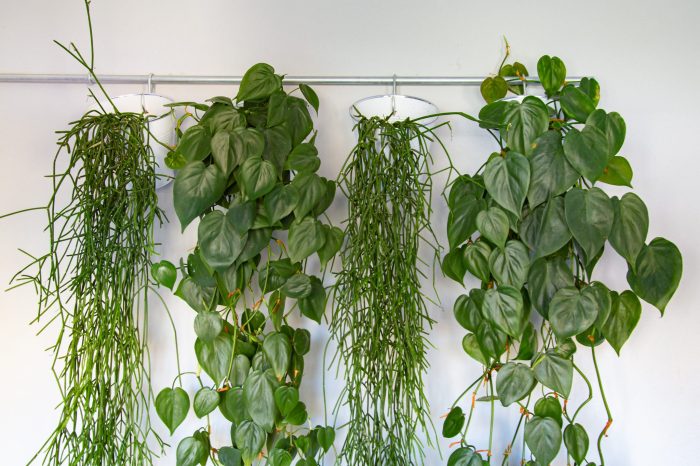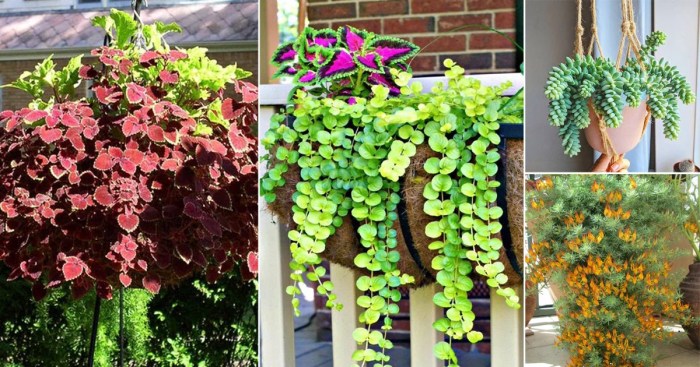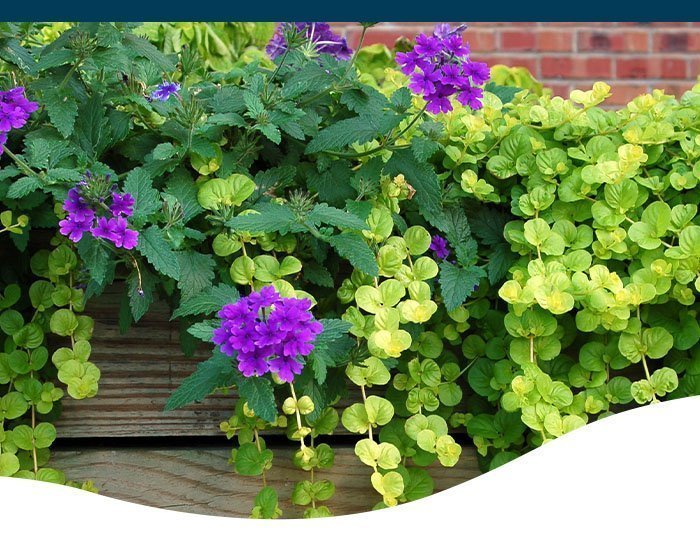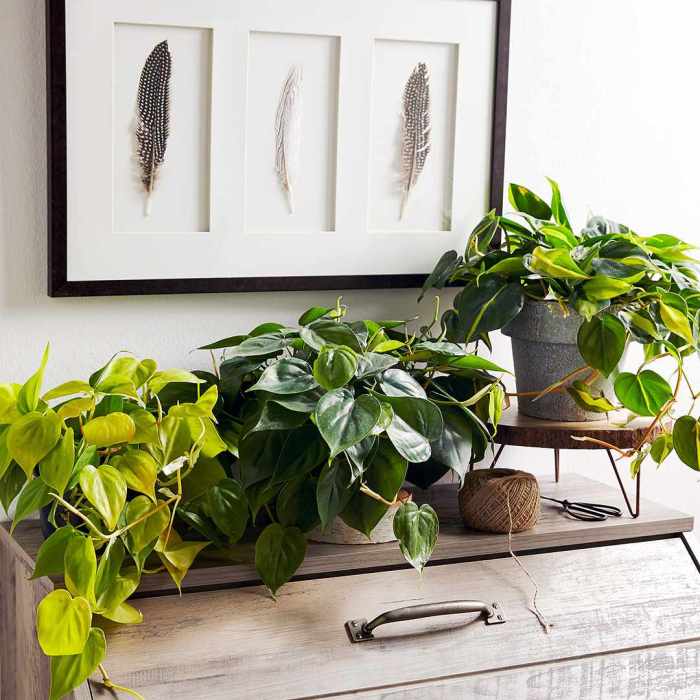Best trailing plants for low light – Unleash the beauty of greenery in low-light areas with the best trailing plants. These enchanting botanical wonders bring a touch of nature’s allure to dimly lit spaces, creating an ambiance that is both soothing and visually captivating.
From cascading vines to lush fronds, trailing plants offer a diverse range of textures, colors, and growth habits, making them ideal for adding a touch of elegance and vitality to any room.
Trailing Plants for Low Light Environments

Trailing plants are known for their cascading growth habit, which makes them ideal for hanging baskets, windowsills, and other areas where they can gracefully drape downwards. Certain trailing plants have adapted to thrive in low-light conditions, making them excellent choices for dimly lit spaces.
Trailing plants can brighten up any room, even those with low light. Some of the best trailing plants for low light include pothos, philodendron, and spider plants. These plants are all easy to care for and can tolerate low light conditions.
If you’re looking for a way to add some greenery to your walls, consider using wall planters. Wall planters are a great way to display plants in small spaces, and they can also help to create a vertical garden. For more information on the best indoor plants for wall planters, click here . When choosing plants for your wall planters, be sure to select those that are suitable for low light conditions.
Characteristics of Low-Light Trailing Plants
Trailing plants that can tolerate low light conditions typically possess certain characteristics that allow them to survive with limited sunlight. These characteristics include:
- Thicker, succulent-like leaves:These leaves store water, enabling the plant to endure periods of low light and infrequent watering.
- Darker green foliage:Plants with darker leaves can absorb more light, making them more efficient at photosynthesis in low-light conditions.
- Slow growth rate:Slow-growing plants generally require less light to maintain their health and appearance.
Examples of Popular Low-Light Trailing Plants
Several trailing plant species are known for their tolerance to low light conditions. Some of the most popular include:
- Pothos (Epipremnum aureum):Pothos is a highly versatile plant that can tolerate a wide range of light conditions, including low light. It has heart-shaped leaves that come in various shades of green, yellow, and white.
- Snake plant (Sansevieria trifasciata):Snake plants are known for their hardiness and low-maintenance nature. They have upright, sword-like leaves that can tolerate low light levels.
- Spider plant (Chlorophytum comosum):Spider plants are easy-to-grow plants that produce long, trailing stems with variegated leaves. They can tolerate low light conditions and are often used in hanging baskets.
- ZZ plant (Zamioculcas zamiifolia):ZZ plants are known for their extreme resilience and can survive in very low light conditions. They have glossy, dark green leaves that add a touch of elegance to any space.
- Peace lily (Spathiphyllum wallisii):Peace lilies are known for their beautiful white flowers that bloom even in low light conditions. They have dark green, glossy leaves that add a touch of sophistication to any room.
By incorporating these low-light trailing plants into your indoor spaces, you can add a touch of greenery and create a welcoming ambiance even in areas with limited natural light.
Benefits of Trailing Plants in Low Light

Trailing plants offer an array of aesthetic benefits in low-light environments, enhancing the ambiance of dimly lit rooms. Their cascading foliage adds visual interest and texture, creating a sense of depth and movement. By incorporating trailing plants into interior design schemes, homeowners can transform dark corners into inviting and vibrant spaces.
Enhancing Ambiance in Low-Light Rooms, Best trailing plants for low light
Trailing plants, with their lush foliage and cascading tendrils, can significantly enhance the ambiance of rooms with limited natural light. They bring a touch of nature indoors, adding life and freshness to otherwise dull spaces. Their soft, flowing forms create a calming and inviting atmosphere, making them ideal for bedrooms, living rooms, and even offices.
Care and Maintenance of Trailing Plants

Trailing plants in low light environments require specific care and maintenance techniques to thrive. Understanding their unique needs and providing proper care ensures their health and aesthetic appeal.
Watering is crucial for trailing plants. Allow the soil to dry out slightly between waterings to prevent root rot. Fertilizing should be done monthly during the growing season using a balanced liquid fertilizer diluted to half strength.
In the realm of indoor gardening, selecting the best trailing plants for low light is crucial. These plants not only add a touch of greenery to dim corners but also purify the air. When paired with best indoor hanging pots , these trailing plants create a stunning display, transforming any room into an oasis of tranquility.
Their cascading foliage spills over the edges of the pots, creating a lush and inviting ambiance that enhances the overall aesthetic appeal.
Pruning Techniques
Regular pruning is essential to maintain the shape and size of trailing plants. Cut back any leggy or overgrown stems to encourage bushier growth. Remove any dead or yellowing leaves to promote healthy foliage.
Common Challenges
Trailing plants in low light can face challenges such as yellowing leaves due to insufficient light. Provide additional light sources if possible or move the plant to a brighter location. Pests like spider mites and mealybugs can also be a problem.
For those seeking low-light options, consider trailing plants that thrive in dimly lit spaces. These include species like the Golden Pothos and Spider Plant. If you’re looking for a more comprehensive guide to indoor trailing plants, including those suitable for low light, refer to our article on the best indoor trailing plant .
Use insecticidal soap or neem oil to control infestations.
Design Considerations for Trailing Plants

Trailing plants offer unique opportunities to add vertical interest and greenery to low-light spaces. Here are some creative ways to incorporate them into your home décor:
Vertical Gardens and Hanging Baskets
Trailing plants thrive in vertical gardens, where their cascading foliage creates a lush, flowing effect. They can be planted in wall-mounted planters or suspended from ceilings. Similarly, hanging baskets provide an ideal environment for trailing plants to showcase their long, graceful stems.
Terrariums and Macrame Plant Hangers
Terrariums create miniature ecosystems that are perfect for trailing plants that prefer high humidity. Their enclosed environment allows for controlled moisture levels and provides a unique display for delicate foliage. Macrame plant hangers, on the other hand, add a touch of bohemian charm while allowing trailing plants to cascade freely.
Table Comparing Trailing Plants for Design Applications
The suitability of trailing plants for different design applications depends on their growth habit, foliage texture, and overall size. Here’s a table comparing popular trailing plants for various scenarios:
| Plant | Vertical Gardens | Hanging Baskets | Terrariums | Macrame Plant Hangers |
|---|---|---|---|---|
| Pothos | ✓ | ✓ | ✓ | ✓ |
| String of Pearls | ✓ | ✓ | ✓ | |
| Spider Plant | ✓ | ✓ | ✓ | |
| Philodendron Scandens | ✓ | ✓ | ✓ | ✓ |
| Burro’s Tail | ✓ | ✓ | ✓ |
Unique Trailing Plants for Low Light: Best Trailing Plants For Low Light

Beyond the common choices, there exists a realm of rare and lesser-known trailing plants that thrive in low light conditions. These botanical wonders possess unique features that elevate any indoor space, offering a captivating blend of aesthetics and resilience.
Echeveria runyonii ‘Topsy Turvy’
With its whimsical rosettes, Echeveria runyonii ‘Topsy Turvy’ is a sight to behold. Its fleshy leaves, shaped like inverted spoons, are a vibrant shade of blue-green, creating a cascading effect as they tumble down. This low-growing succulent prefers well-draining soil and infrequent watering, making it an ideal choice for those seeking a low-maintenance companion.
Dischidia nummularia ‘Watermelon’
Hailing from the jungles of Southeast Asia, Dischidia nummularia ‘Watermelon’ boasts round, watermelon-like leaves with intricate veins. Its delicate tendrils trail gracefully, showcasing its unique foliage. As an epiphyte, it thrives on tree bark or mounted on a wall, adding a touch of the tropics to indoor environments.
Nematanthus gregarius ‘Rio Silver’
Nematanthus gregarius ‘Rio Silver’ is a stunning trailing plant that produces a profusion of silver-striped leaves. Its foliage cascades beautifully, creating a silvery waterfall effect. This plant prefers bright, indirect light and moist soil, rewarding its caretaker with vibrant foliage and occasional trumpet-shaped flowers.
Selaginella uncinata ‘Peacock Fern’
Known for its delicate and feathery foliage, Selaginella uncinata ‘Peacock Fern’ adds a touch of whimsy to any space. Its emerald-green leaves are arranged in intricate patterns, resembling a peacock’s plumage. This fern prefers high humidity and moist soil, thriving in terrariums or near water sources.
Asparagus densiflorus ‘Sprengeri’
Asparagus densiflorus ‘Sprengeri’ is a versatile trailing plant that can add a touch of greenery to any corner. Its feathery, needle-like foliage cascades gracefully, creating a lush and voluminous effect. This plant is tolerant of low light and infrequent watering, making it a popular choice for busy plant enthusiasts.
Last Word
Incorporating trailing plants into your low-light spaces is not only aesthetically pleasing but also beneficial for your well-being. Their ability to purify the air and create a sense of tranquility makes them invaluable additions to any home or office.
With proper care and maintenance, these resilient plants will thrive in low-light conditions, bringing years of beauty and joy to your indoor environment.
Key Questions Answered
What are the most popular trailing plants for low light?
Some of the most popular trailing plants for low light include pothos, philodendron, spider plants, and ZZ plants.
How often should I water trailing plants in low light?
Trailing plants in low light typically require less watering than those in brighter conditions. Allow the soil to dry out slightly between waterings.
Can trailing plants help purify the air?
Yes, many trailing plants have air-purifying qualities. Some of the best air-purifying trailing plants include pothos, philodendron, and spider plants.